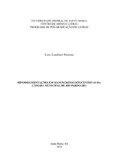| dc.creator | Moreira, Leici Landherr | |
| dc.date.accessioned | 2021-08-26T18:22:12Z | |
| dc.date.available | 2021-08-26T18:22:12Z | |
| dc.date.issued | 2019-12-18 | |
| dc.identifier.uri | http://repositorio.ufsm.br/handle/1/22078 | |
| dc.description.abstract | The aim of this research is to characterize the hypo-segmentations in nineteenth-century manuscripts of the Municipal Council from the Rio Pardo City, in the Rio Grande do Sul, under the theoretical contribution of the Historical Sociolinguistics. Hypo-segmentations are a form of graphical variation, which consists of the suppression of white gaps between words written in a continuous way. We believe that the phenomenon of hypo-segmentation is a characteristic of the nineteenth-century writing practice of official documents of the Rio Pardo Council, and which presents a linguistic motivation of prosodic nature. The research corpus comprises 28 manuscripts from the 1912 Códice Geral of the council, collected in the Historical Council Archive - Biágio Soares Tarantino, and classified as a letter, receipt, court order, term of possession and provision. A facsimile and semi diplomatic edition of the texts are displayed in the first part of this research. In the second part, we propose the linguistic study of 410 occurrences of hypo-segmented forms from methodological procedures adapted from Historical Sociolinguistics, which include paleographic variables, linguistic variables, and social-historical variations. The results indicate that a hypo-segmentation, mainly a lexical word with a clitic, could be a predetermined form of writing and already fixed as the clerks' graphic particularity. In that case, a linguistic motivation for the phenomenon would consist in the fact of the clerk perceiving the presence of host and clitic, but verifying the prosodic dependence of the clitic on the host, thus recording a phonological sentence. This fact may be associated with the particularity of the practice of the clerks in written documents as far as it reveals the knowledge of the clerks about word boundaries and the clitic's dependence on the lexical word, marked by the absence of graphic direction between the elements. As the hypo-segmentation occurs in all types of documents, and the clerks show mastery of document structure and familiarity with writing due they deal with paperless writing of the functions required by the position, we believe in the hypothesis of hypo-segmentation as a characteristic of the nineteenth-century writing practice of official and administrative documents written in the Rio Pardo, possibly extending to other parts of the Rio Grande do Sul. | eng |
| dc.description.sponsorship | Coordenação de Aperfeiçoamento de Pessoal de Nível Superior - CAPES | por |
| dc.language | por | por |
| dc.publisher | Universidade Federal de Santa Maria | por |
| dc.rights | Attribution-NonCommercial-NoDerivatives 4.0 International | * |
| dc.rights.uri | http://creativecommons.org/licenses/by-nc-nd/4.0/ | * |
| dc.subject | Hipossegmentações | por |
| dc.subject | Edição de textos | por |
| dc.subject | Prática de escrita | por |
| dc.subject | Prosódia | por |
| dc.subject | Hypo-segmentations | eng |
| dc.subject | Text editing | eng |
| dc.subject | Writing practice | eng |
| dc.subject | Prosody | eng |
| dc.title | Hipossegmentações em manuscritos oitocentistas da Câmara Municipal de Rio Pardo (RS) | por |
| dc.title.alternative | Hypo-segmentations in eighth-century manuscripts of the municipal council of the Rio Pardo (RS) | eng |
| dc.type | Dissertação | por |
| dc.description.resumo | Esta pesquisa tem o objetivo caracterizar as hipossegmentações em manuscritos oitocentistas da Câmara Municipal de Rio Pardo, no Rio Grande do Sul, sob o aporte teórico da Sociolinguística Histórica. As hipossegmentações são um tipo de variação gráfica, que consiste na supressão do espaço em branco entre palavras, grafadas de modo contínuo. Acreditamos que o fenômeno de hipossegmentação seja uma característica da prática de escrita oitocentista de documentos oficiais da Câmara de Rio Pardo, e que tenha uma motivação linguística de ordem prosódica. O corpus da pesquisa compreende 28 manuscritos do Códice Geral de 1912 da Câmara, coletados no Arquivo Histórico Municipal Biágio Soares Tarantino, e classificados em ofício, recibo, mandado, termo de posse e provisão. Na primeira parte do trabalho, apresenta-se o fac-símile e edição semidiplomática dos textos. Na segunda parte, propõe-se o estudo linguístico de 410 ocorrências de formas hipossegmentadas a partir de procedimentos metodológicos adaptados da Sociolinguística Histórica, que contemplem variáveis paleográficas, variáveis linguísticas, e variáveis sócio-históricas. Os resultados indicam que a hipossegmentação, principalmente de uma palavra lexical com clítico, poderia ser uma forma de escrita pré-estabelecida e já fixada como particularidade gráfica dos escreventes. Nesse caso, a motivação linguística para o fenômeno consistiria no fato de o escrevente perceber a existência do hospedeiro e do clítico, mas assinalar a dependência prosódica do clítico em relação ao hospedeiro, registrando, assim, uma frase fonológica. Esse fato pode ser associado à particularidade da própria prática de escrita dos escreventes na medida em que revela o conhecimento do escrevente acerca dos limites das palavras e da dependência do clítico em relação à palavra lexical, marcada pela ausência de fronteira gráfica entre os elementos. Como há ocorrência de hipossegmentações em todos os tipos documentais, e os escreventes apresentam domínio da estrutura dos documentos e familiaridade com o ato de escrever por conta de lidarem com a escrita no âmbito das funções exigidas pelo cargo, acreditamos na hipótese de a hipossegmentação ser uma característica da prática de escrita oitocentista de documentos oficiais e administrativos escritos em Rio Pardo, possivelmente estendendo-se ao Rio Grande do Sul. | por |
| dc.contributor.advisor1 | Costa, Evellyne Patricia Figueiredo de Sousa | |
| dc.contributor.advisor1Lattes | http://lattes.cnpq.br/3603215516050476 | por |
| dc.contributor.referee1 | Sturza, Eliana Rosa | |
| dc.contributor.referee2 | Fachin, Phablo Roberto Marchis | |
| dc.creator.Lattes | http://lattes.cnpq.br/0229181862964051 | por |
| dc.publisher.country | Brasil | por |
| dc.publisher.department | Letras | por |
| dc.publisher.initials | UFSM | por |
| dc.publisher.program | Programa de Pós-Graduação em Letras | por |
| dc.subject.cnpq | CNPQ::LINGUISTICA, LETRAS E ARTES::LETRAS | por |
| dc.publisher.unidade | Centro de Artes e Letras | por |



